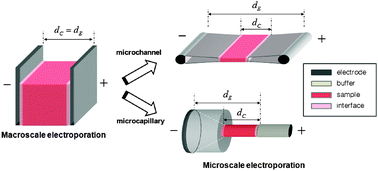Microscale engineering plays a significant role in developing tools for biological applications by miniaturizing devices and providing controllable microenvironments for in vitro cell research. Miniaturized devices offer numerous benefits in comparison to their macroscale counterparts, such as lower use of expensive reagents, biomimetic environments, and the ability to manipulate single cells. Microscale electroporation is one of the main beneficiaries of microscale engineering as it provides spatial and temporal control of various electrical parameters. Microscale electroporation devices can be used to reduce limitations associated with the conventional electroporation approaches such as variations in the local pH, electric field distortion, sample contamination, and the difficulties in transfecting and maintaining the viability of desired cell types. Here, we present an overview of recent advances of the microscale electroporation methods and their applications in biology, as well as current challenges for its use for clinical applications. We categorize microscale electroporation into microchannel and microcapillary electroporation. Microchannel-based electroporation can be used for transfecting cells within microchannels under dynamic flow conditions in a controlled and high-throughput fashion. In contrast, microcapillary-based electroporation can be used for transfecting cells within controlled reaction chambers under static flow conditions. Using these categories we examine the use of microscale electroporation for clinical applications related to HIV-1, stem cells, cancer and other diseases and discuss the challenges in further advancing this technology for use in clinical medicine and biology.

You have access to this article
 Please wait while we load your content...
Something went wrong. Try again?
Please wait while we load your content...
Something went wrong. Try again?


 Please wait while we load your content...
Please wait while we load your content...